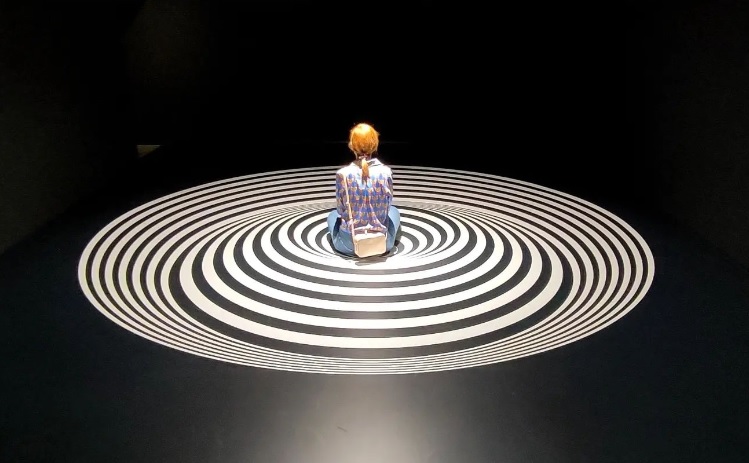The look, the things, the deceptions
from Magritte to augmented reality
inauguration Friday 8 July at 6.30 pm
edited by Chiara Gatti and Tiziana Cipelletti
with the scientific contribution of Baingio Pinna of the Department of Biomedical Sciences of the University of Sassari, author of the book Visual perception , the Mill, 2021
Exhibition project by Denis Santachiara
Coordination of Rita Moro and Elisabetta Masala
Video installations by Storyville
SENSORAMA adopts the model of the Museum of Illusions in a cultured and original way and entrusts the works of contemporary artists and videomakers with the exploration of the relationship between Vision and Perception with the aim of showing the complexity of cognitive phenomena and the “pleasure” of being deceived.
Illusion is our reality. Because we see little of the world out there that our eyes are able to see. “How your eyes trick your mind”, as the English say. The result is a representation of things that is not real at all. It’s up to our brain to orient ourselves between appearances and enigmas.
Those who deal with perception start from these premises, but know that they have centuries of philosophical discussion behind them, from Plato onwards. The question “do we really see reality?” It’s an age-old dilemma. Today, however, neuroscience can begin to provide an answer by studying the sense organs and analyzing the brain’s ability to interpret the signals that they send it.
The MAN museum in Nuoro, which has always been dedicated to research and the different languages of the contemporary, inaugurates a new exhibition season which aims to reflect on some themes prompted by the drama of the pandemic and confinement: interrupted communication, the gaze veiled by the diaphragm of a screen, the reading of images removed from sight and returned in a virtual reality. Going back to look, to train the eyes and to ask questions about the truth (or otherwise) of vision is the aim of an exhibition which, starting from historical antecedents, from the noble fathers of a painting of truth and deception, such as René Magritte and Giorgio de Chirico, it opens the spectrum to the most recent aesthetic investigations into perception and authenticity. Here are the mirror photographs of Florence Henri or the optical-kinetic tables of Alberto Biasi, the enveloping and disturbing environments of Peter Kogler or Marina Apollonius; and again, the anamorphic sculptures of Marc Didou or the performances understood as real human trompe-l’œil of Liu Bolin, the invisible man.
The title of the exhibition SENSORAMA it is inspired by the name of a machine created in 1957 by the American director Morton Heilig to test synesthetic experiences in his cinema of experience, in order to amplify impressions, not only sound with stereophonic audio, but also tactile, dynamic and olfactory. To see the music is the name of a section reserved for discovering synesthesia, the psychic automatism which consists in associating two contents referring to two different sensory spheres in a single image.
SENSORAMA is a lot of cinema, art of fireworks par excellence, “factory of illusions” since its debut and ground of visual experimentation of the avant-garde. The exhibition itinerary contemplates the fantastic cinematography of George Melies based on the disappearance of objects obtained with a primitive stop frame and the levitation of things and people with stop-motion shooting, to arrive at the phantasmagoric interactions between artistic avant-gardes (Léger, Man Ray, Picabia, Cocteau, Duchamp…) and cinema. Experimental cinema which, by adopting the statute of magic and playing with deception and perceptive deformations, throws our “usual” experience of reality to pieces.
The wonderful paradoxes of the digital age. With the augmented reality installation, “non-reality” goes beyond its boundaries, floods our perception and gives access to new meanings in a multilayer vision/version. Without the use of devices, but thanks to the use of your own mobile phone (Bring Your Own Device), you will be able to experience the “intelligent and complex” fascination of a multi-layered content, an essential completion of the vision of a world in transition.
The project is enriched by site specific installations, for example in the case of the interventions studied ad hoc for the MAN by artists such as Felice Varini , author of drawings in space, both monumental and ephemeral, as well as a magical room designed by the designer Denis Santachiara and a cave of books dug like rocks by imprints of impalpable bodies created by Marco Cordero.
SENSORAMA in short, it wants to represent the zero degree of perception, useful for cleaning up the gaze, to return to amaze ourselves in the face of the paradoxes of sight, to start observing the works again with an inquiring gaze, to get closer to the images aware of a fluid limit between real and virtual, but ready to sharpen our eyes to reveal the mechanisms that orchestrate the process of vision itself. An invitation to learn to look. But, above all, to doubt.
Artists
René Magritte, Giorgio de Chirico, Florence Henri, Alberto Biasi, Luigi Mazzarelli, Peter Kogler, Felice Varini, Marina Apollonio, Denis Santachiara, Marc Didou, Peter Miller, Liu Bolin, Marco Cordero, Humans since 1982, Ole Martin Lund Bø, Paolo Cavinato, Cinzia Fiorese, Marco Di Giovanni, Kensuke Koike.
Electa catalog with texts by Baingio Pinna, Chiara Gatti and Tiziana Cipelletti
Press office
ESSECI study by Sergio Campagnolo
tel. 049.66.34.99
Contact Simone Raddi: simone@studioesseci.net


